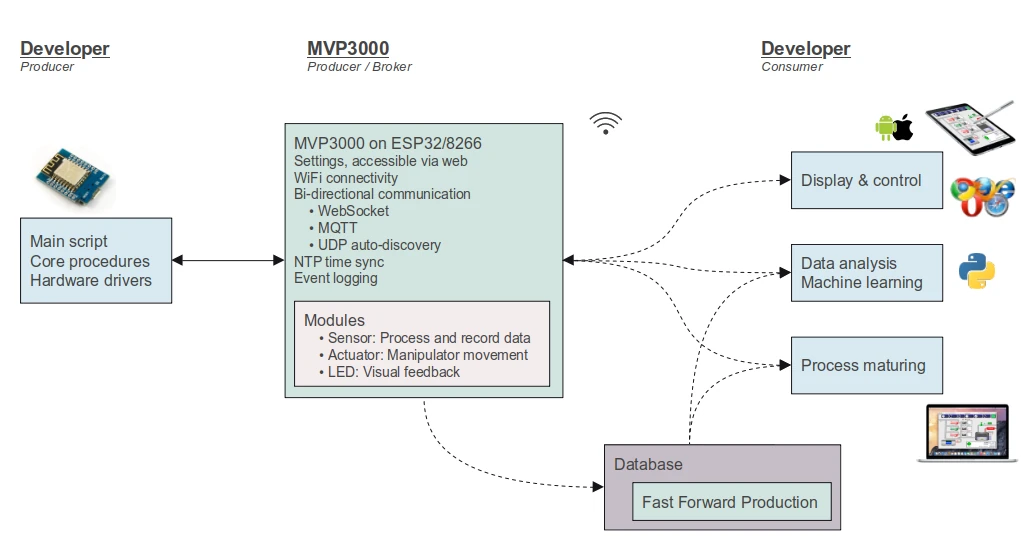The MVP3000 framework is built to streamline the implementation of sensor and actuator hardware. It facilitates a seamless transitions between all development stages and thus speeds up the implementation cycle. It allows the rapid development of a MVP (minimum viable product) for demonstration purposes. It allows the rapid deployment in fabrication for the purpose of deskilling and improving process reliability. It ensures efficient and reliable data collection for statistical analysis or machine learning. Designed around low-cost hardware and open-source software, its modular structure promotes fast, flexible, and agile hardware development.

Focus on High-Value Tasks
The framework takes care of mundane tasks such as processing data and communication, freeing the developer to focus on high-value, impactful work. Core product features can be developed and tested independently, then seamlessly integrated into the main product. This structure ensures rapid user feedback, significantly accelerating the implementation and improvement cycle.

The effort to create a MVP for demonstration is minimal, requiring only the C++ script for core functionality and a HTML/CSS webpage for display on a touch device, like a smartphone. Everything else is reliably handled in the background by the MVP3000 framework:
- WiFi Connectivity: Configurable as either an access point or joining an existing network.
- Settings Interface: Accessible via web for both framework and module configuration.
- Alternative Custom Web Page: Customizable display options for end-user interaction.
- Bi-Directional Communication: Supports data and control using standard WebSocket and MQTT (for local or internet-based brokers). Implements a custom UDP auto-discovery protocol to automatically locate devices and a MQTT broker on the local network.
- Time Synchronization: NTP time sync ensures accurate timestamps.
- Event Logging: Automated logging of key events.

Seamless Transition Between Development Stages
From an engineering perspective, the always changing communication needs when moving from one development stage to the next are a main source of (redundant) work. The MVP3000 framework addresses this by separating roles into Publisher, Broker, and Consumer, using standard communication protocols to ensure a seamless transition across configurations.
- Cable Connection: Initial proof-of-concept testing.
- One-to-One: Simple configuration for MVP deployment and demonstrations.
- Many-to-One: Typical configuration in stand-alone systems for process automation.
- One-to-Many/Many-to-Many: Optimal during development, supporting simultaneous use of a demonstrator MVP and active data collection.
- Local Network vs. Remote Location: Works with both internal networks and remote customer-site deployments.

Extend Functionality Using Modules
The framework includes a set of modules that extend functionality for common applications, while also allowing the creation of custom modules. Custom modules can leverage core features like settings management, web interface, and communication protocols to streamline development.
Sensor Module: Accepts data from the user script and processes it.
- Performs data averaging, offset adjustments, scaling, and tare
- Publishes timestamped live data to the serial console, WebSocket, and MQTT.
- Receives commands and settings via the web interface, WebSocket, and MQTT.
- Stores data locally and provides recent measurements as downloadable CSV files.
LED Module: Provides high-level functionality
- Includes basic effects, such as blinking, for status indication or interactive cues.
- Provides automatic brightness adjustment if a photosensor is connected.
Actuator Module: Interfaces with stepper motor hardware.
- Facilitates common movement and scan functions, controlled via WebSocket and MQTT.
- Integrates seamlessly with the sensor module for coordinated operation.
- Currently not available as open-source.

Codebase
Built around readily available low-cost ESP8266/ESP32 micro controller and open libraries, the MVP3000 framework itself is open-source and licensed under the Apache 2 license.
Clone the repositories from
GitHub (Apache 2 license).
– or –
Contact us for support and
serviced hosting options.
Application Note: CO2-Lights (CO2-Ampel)
The CO2-Lights implementation serves as a showcase application that highlights the versatility of the MVP3000 framework. This implementation uses the sensor module and the LED module. It features a custom landing page accessible via any smartphone or browser. The page provides real-time ambient CO2 concentration data alongside a historical graph, which updates automatically through WebSocket.

